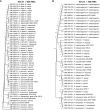Isolation, identification, and significance of salivary Veillonella spp., Prevotella spp., and Prevotella salivae in patients with inflammatory bowel disease
- PMID: 38053528
- PMCID: PMC10694262
- DOI: 10.3389/fcimb.2023.1278582
Isolation, identification, and significance of salivary Veillonella spp., Prevotella spp., and Prevotella salivae in patients with inflammatory bowel disease
Abstract
The global prevalence of inflammatory bowel disease (IBD) is on the rise, prompting significant attention from researchers worldwide. IBD entails chronic inflammatory disorders of the intestinal tract, characterized by alternating flares and remissions. Through high-throughput sequencing, numerous studies have unveiled a potential microbial signature for IBD patients showing intestinal enrichment of oral-associated bacteria. Simultaneously, the oral microbiome can be perturbed by intestinal inflammation. Our prior investigation, based on 16S rRNA amplicon sequencing, underscored elevated abundance of Veillonella spp. and Prevotella spp. in the salivary microbiomes of IBD patients. Noteworthy, Prevotella salivae emerged as a distinct species significantly associated with IBD. P. salivae is an under-recognized pathogen that was found to play a role in both oral and systemic diseases. In this study, we delve deeper into the salivary microbiomes of both IBD patients and healthy controls. Employing diverse cultivation techniques and real-time quantitative polymerase chain reactions (RT-qPCR), we gauged the prevalence and abundance of Veillonella spp., Prevotella spp., and P. salivae. Our isolation efforts yielded 407 and 168 strains of Veillonella spp., as well as 173 and 90 strains of Prevotella spp., from the saliva samples of IBD patients and healthy controls, respectively. Veillonella-vancomycin agar emerged as the discerning choice for optimal Veillonella spp. cultivation, while Schaedler kanamycin-vancomycin agar proved to be the most suitable medium for cultivating Prevotella spp. strains. Comparing our RT-qPCR findings to the previous 16S rRNA amplicon sequencing data, the results corroborated the higher abundance of Veillonella spp., Prevotella spp., and P. salivae in the saliva of IBD patients compared to healthy controls. However, it's worth noting that in contrast to RT-qPCR, the 16S rRNA amplicon sequencing data revealed greater absolute abundance of all three bacterial groups in both IBD patients and controls.
Keywords: 16S rRNA amplicon sequencing; Prevotella salivae; Prevotella spp.; Veillonella spp.; inflammatory bowel disease; real-time quantitative PCR.
Copyright © 2023 Hammad, Conrads and Abdelbary.
Conflict of interest statement
The authors declare that the research was conducted in the absence of any commercial or financial relationships that could be construed as a potential conflict of interest.
Figures




Similar articles
-
The oral-gut axis: Salivary and fecal microbiome dysbiosis in patients with inflammatory bowel disease.Front Cell Infect Microbiol. 2022 Oct 7;12:1010853. doi: 10.3389/fcimb.2022.1010853. eCollection 2022. Front Cell Infect Microbiol. 2022. PMID: 36275026 Free PMC article.
-
Dysbiosis of salivary microbiota in inflammatory bowel disease and its association with oral immunological biomarkers.DNA Res. 2014 Feb;21(1):15-25. doi: 10.1093/dnares/dst037. Epub 2013 Sep 7. DNA Res. 2014. PMID: 24013298 Free PMC article.
-
Dysbiotic salivary microbiota in dry mouth and primary Sjögren's syndrome patients.PLoS One. 2019 Jun 18;14(6):e0218319. doi: 10.1371/journal.pone.0218319. eCollection 2019. PLoS One. 2019. PMID: 31211815 Free PMC article.
-
Salivary Microbiome Diversity in Caries-Free and Caries-Affected Children.Int J Mol Sci. 2016 Nov 25;17(12):1978. doi: 10.3390/ijms17121978. Int J Mol Sci. 2016. PMID: 27898021 Free PMC article.
-
The oral microbiome and human health.J Oral Sci. 2017;59(2):201-206. doi: 10.2334/josnusd.16-0856. J Oral Sci. 2017. PMID: 28637979 Review.
Cited by
-
The Role of Prevotella Species in Female Genital Tract Infections.Pathogens. 2024 Apr 28;13(5):364. doi: 10.3390/pathogens13050364. Pathogens. 2024. PMID: 38787215 Free PMC article. Review.
-
Swabs versus native specimens in severe head and neck infections: a prospective pilot study and suggestions for clinical management.Oral Maxillofac Surg. 2025 Apr 14;29(1):81. doi: 10.1007/s10006-025-01382-y. Oral Maxillofac Surg. 2025. PMID: 40227323 Free PMC article.
-
Undaria pinnatifida Fucoidan Enhances Gut Microbiome, Butyrate Production, and Exerts Anti-Inflammatory Effects in an In Vitro Short-Term SHIME® Coupled to a Caco-2/THP-1 Co-Culture Model.Mar Drugs. 2025 Jun 4;23(6):242. doi: 10.3390/md23060242. Mar Drugs. 2025. PMID: 40559651 Free PMC article.
-
Human oral microbiome and its influence on mental health and brain disorders.AIMS Microbiol. 2025 Apr 14;11(2):242-294. doi: 10.3934/microbiol.2025013. eCollection 2025. AIMS Microbiol. 2025. PMID: 40600213 Free PMC article. Review.
References
Publication types
MeSH terms
Substances
Supplementary concepts
LinkOut - more resources
Full Text Sources
Miscellaneous

